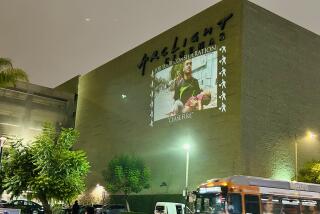Taggers Plugging In to a Creative Outlet
The graffiti that adorned the walls of a Westside architecture firm looked like the kind of scrawl the city spends millions of dollars a year trying to paint over.
But instead of sneers, this graffiti earned thoughtful nods and, at times, enthusiastic smiles from visitors sipping chardonnay and eating cheese. At the end of the evening, a few of the spray-painted canvases sold at auction for more than $500 each.
The art show, held in February, is part of what organizers hope is a novel effort to prevent graffiti vandalism. Los Angeles Police Chief William J. Bratton has made the removal of graffiti from walls, freeway signs and other places a priority, saying itâs an important step in preventing more serious crimes.
But those who set up the ArtStorm show believe Brattonâs efforts only deal with half of the problem. They argue that those who vandalize need a place to produce their work. They want to set up traveling graffiti art shows and are talking with city officials about creating a permanent community center where taggers can come to do more artistic work.
The push to treat taggers like artists doesnât sit well with some anti-graffiti activists.
âI say graffiti is not art. How many tags have you seen that were actually artistic?â said Delphia Jones, director of Operation Clean Sweep, which spends $6 million a year removing graffiti in Los Angeles.
âThese types of programs have been tried in the past,â Jones added. âThereâs a [sanctioned] graffiti wall in Long Beach and one in Venice near the boardwalk. And as far as I can determine, they really do not deter graffiti vandalism. Tagging actually increases in those areas.â
Some of the hundred or so visitors to the gallery at the SPF Architects firm came with skepticism but said they were won over. As patrons watched, the painters went to work on 3-by-8 foot canvases, creating abstract and impressionistic scrawls of spray paint and acrylics forming jagged letters colored in reds and grays.
âI was just told, âBe aware thereâs going to be a lot of fumes,â â said Mark Peacor, a Santa Monica architect who wandered through the gallery for his introduction to graffiti at ArtStorm. âI understand this is graffiti, but these guys are talented. You can see it.â
Organizers of ArtStorm believe the city needs to look more creatively at deterring vandalism. Their solution: Give graffiti artists a safe, legal venue in which to do their work.
Itâs âa preventive solution that deals with the issue at [the] root cause,â said Steve Bagish, a business consultant and ArtStormâs founder.
While some police and graffiti removal workers might disagree, this concept of graffiti as art is gaining support in some quarters of local government.
The Los Angeles Cultural Affairs Department in recent years has awarded partial grants for graffiti artists to lead after-school programs for younger children. In these cases, they encourage sketching as well as talking about color theory and composition in graffiti.
âItâs very misunderstood. The word graffiti has become stigmatized,â said Elizabeth Morin, a program director in the Cultural Affairs Department. The artists âreally want to put something beautiful up, they want to contribute something aesthetic, and it can be in removable panels we can see in places like museums.â
But she added: âWe absolutely do not condone vandalism, but we do promote safe, legal art-making.â
The Metropolitan Transportation Authority is considering a plan to rotate graffiti art exhibits on the new Gold Line railway, a project proposed by ArtStorm.
Bagish has also been in discussions with representatives of City Council members Ed Reyes and Nick Pacheco to organize âgraffiti art toursâ of the finest murals in their districts.
There are even plans being considered by developers and architects for an aerosol art park, which would feature renewable easels, an art supply franchise, a restaurant and a stage for live performances. The SPF architects, who hosted the art party, have drawn up models, and Bagish said the group has started raising money for the $1.2-million project.
âWe know that hundreds of thousands of young people love aerosol art with enough passion to hang from freeway overpasses to do their art,â Bagish said. âWe know there are not a lot of means for them to do it constructively and legally, so the whole thing is to pursue excellence, to practice your craft and become a master.â
Bagishâs hope is that if graffiti art is more embraced in the mainstream, some taggers might be able to enter careers in commercial artwork, trading in their aerosol cans for acrylics and oil paints.
âThis isnât just tagging,â said John Gee, a former tagger under the name Pryer. For years, he was a prolific graffiti vandal who even served time in jail. Now he does commercial print work.
Still, some taggers say that the illicit nature of what they do is a big appeal.
At the ArtStorm show, one participant who goes by the name Jerk said no matter how involved some taggers get in the mainstream art scene, they still do their most inspired work at night on walls that donât belong to them.
âItâs part of our history, thatâs just the way it is,â said Jerk, who declined to give her real name.
âGraffiti is meant to be on walls,â she said. Pointing to collectors picking out pieces to take home she added: âAnd this is making us a living, just like anything else.â
More to Read
Sign up for Essential California
The most important California stories and recommendations in your inbox every morning.
You may occasionally receive promotional content from the Los Angeles Times.










